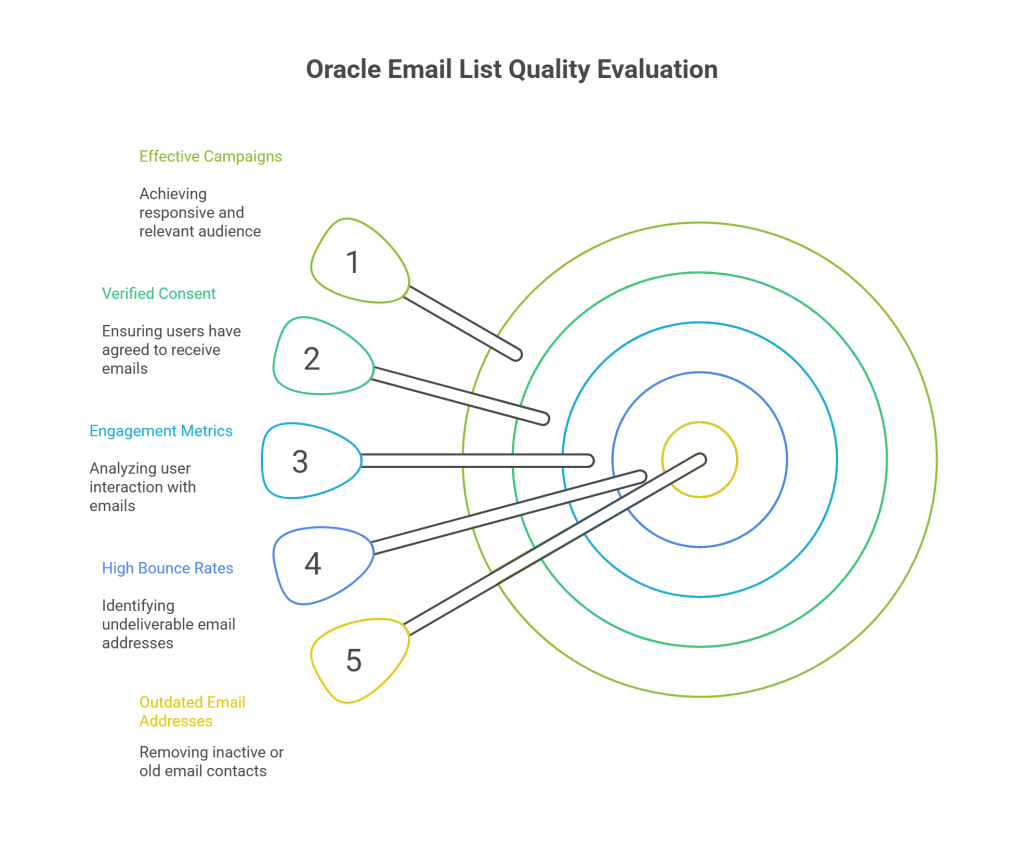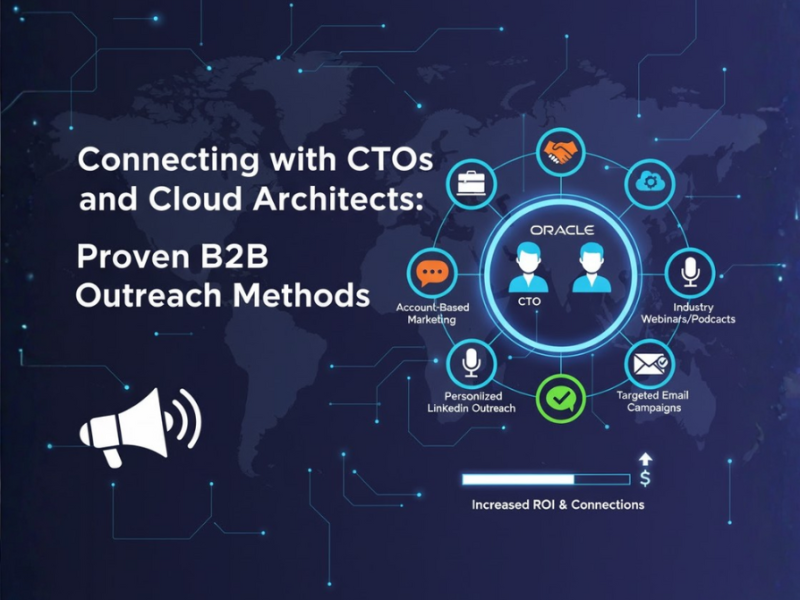In the high-stakes arena of B2B marketing, a targeted email list is your most potent weapon. While email marketing boasts an average ROI of up to $42 for every $1 spent, the foundation of this success isn’t the email copy or the flashy graphics – it’s the list.
For businesses aiming to connect with the lucrative and influential market of Oracle users, the quality of that list is the bedrock of their entire campaign strategy. A pristine, accurate, and well-vetted list can yield remarkable returns, opening doors to valuable partnerships and sales.
Conversely, a low-quality one can drain your budget, tarnish your brand reputation, and deliver nothing but the dispiriting silence of an empty inbox.

To safeguard your marketing efforts, it’s crucial to recognize the warning signs of a subpar list. To protect your marketing investment and ensure campaign success, this article will reveal the five critical red flags of a low-quality Oracle users email list that every marketer needs to recognize.
This guide will provide you with the essential knowledge to make informed data-purchasing decisions, turning a potential liability into a powerful asset for lead generation.
Red Flag #1: The Price is Too Good to Be True
The allure of a bargain is strong, but in the world of B2B data, an exceptionally low price is almost always a sign of a hidden cost. If a vendor offers you a comprehensive Oracle users email list for a fraction of the market rate, your internal alarm bells should be ringing.
The Economics of Quality Data: Compiling and maintaining an accurate and verified database of niche technology users is a resource-intensive process. Reputable data providers invest heavily in research, manual verification, and technology to ensure their data is current and relevant.
This includes confirming which specific Oracle products are in use (e.g., Oracle ERP Cloud, Oracle Database, NetSuite), verifying job titles and responsibilities, and continuously updating contact information. These operational costs are naturally factored into the price of a high-quality list.
The “Bargain” List Trap: An unbelievably low price often indicates that corners have been cut. The list is likely riddled with outdated information, populated with generic or scraped contacts, or is a non-exclusive list that has been sold to hundreds of other companies, including your direct competitors.
Using such a list will lead to high bounce rates, low engagement, and a damaged sender reputation, making it a false economy that costs more in the long run. Imagine paying $0.05 per contact for a list of 10,000 users, only to find that 40% of the emails bounce and the rest show no engagement.
Compare that to a more realistically priced list at $0.50 per contact that has been recently verified and guarantees a bounce rate under 5%. The latter is a strategic investment in data quality; the former is a waste of $500.
Red Flag #2: Lack of Transparency and Vague Data Sources
A reputable data vendor is a partner, not just a supplier. Like any good partner, they should be open and transparent about their processes, especially concerning where their data comes from.
The Importance of Data Provenance: You have a right to know how the contact information on your list was obtained. Legitimate vendors will be upfront about their data collection methods, which often include event sponsorships, professional directories, newsletter sign-ups, and proprietary research panels.
They understand that the legitimacy of their data is their primary value proposition.
Signs of a Shady Vendor: Be wary of any provider who is evasive or gives vague answers when you inquire about their sources. A refusal to provide a data sample is an even more significant warning sign, as it suggests the vendor knows the quality is poor.
A reputable provider of an Oracle users email list will always be transparent about their data collection methods and will have a clear data privacy policy readily available. If they can’t or won’t share this information, it’s best to walk away.
Red Flag #3: Unrealistic Guarantees and High Bounce Rate Promises
In email marketing, perfection is a myth. Any vendor who promises otherwise is selling you a fantasy that can harm your marketing campaign ROI.
The Reality of Email Deliverability: The world of B2B data is in constant flux. People change jobs, companies merge, and email addresses are deactivated. Industry data suggests that B2B data can decay at a rate of 20-30% per year. Therefore, a 100% deliverability rate is an impossible standard. A high-quality list will have a low bounce rate – typically under 5% – but never zero.
The False Promise of Perfection: Caution is advised when a vendor promises “guaranteed inbox placement” or “zero bounces.” These are often high-pressure sales tactics designed to close a deal quickly without scrutiny.
An honest vendor will instead discuss their data hygiene and verification processes, explaining how they work to minimize bounces and maximize deliverability, setting realistic expectations from the outset.
Red Flag #4: Poor Data Segmentation and Lack of Customization
The term “Oracle users” represents a vast and diverse audience. A generic, one-size-fits-all list is an outdated tool that leads to generic, ineffective marketing. The power of a modern B2B marketing campaign lies in its precision.
The Power of Niche Targeting: A quality list should offer multiple segmentation options to help you refine your target audience. Blasting the same message to a CFO and a Database Administrator is inefficient. The ability to tailor your message to the specific needs and pain points of a narrow audience segment is what drives engagement and conversion.
Essential Segmentation Fields: A valuable Oracle users email list should allow you to filter and segment contacts based on crucial data points, including:
- Specific Oracle products used: Oracle ERP Cloud, Oracle Database, NetSuite, PeopleSoft, etc.
- Job titles/roles: IT Manager, Database Administrator, CFO, Controller, HR Director.
- Company size and industry: Manufacturing, Finance, Healthcare, etc.
- Geographic location: Country, State, or City.
For example, consider the difference between sending a generic email about “Oracle solutions” to 10,000 contacts versus sending a highly targeted campaign about “Optimizing Financial Reporting with Oracle ERP Cloud” specifically to 500 CFOs in the manufacturing sector. The latter is infinitely more likely to generate qualified leads.
Read More:- Top Companies Using SAP ERP In 2025
Red Flag #5: No Mention of Data Compliance (GDPR, CCPA, etc.)
In today’s data-sensitive world, compliance is not optional. A failure to adhere to data privacy regulations can have severe and lasting consequences for your business.
The Non-Negotiable Need for Compliance: Global regulations like the General Data Protection Regulation (GDPR) in Europe and the California Consumer Privacy Act (CCPA) have established strict rules for how personal data can be collected, stored, and used for marketing. Using a non-compliant list is not just unethical; it’s illegal.
The Risks of Non-Compliance: The penalties for violating these regulations are severe, including fines that can run into millions of dollars. Beyond the financial cost, a compliance breach can cause irreparable damage to your brand’s reputation and can lead to your domain being blacklisted by email service providers, crippling your future email marketing efforts.
The Compliance Checklist: Before purchasing any list, ask the vendor these critical questions:
- How do you ensure GDPR and CCPA compliance?
- Can you provide documentation or evidence of consent for the contacts on your list?
- What is your process for handling opt-out and data removal requests?
A legitimate vendor will welcome these questions and have clear, confident answers.
Conclusion: Your Shield Against Ineffective Marketing
The appeal of a quick and easy solution for building your marketing pipeline is understandable, but the significant risks associated with a low-quality Oracle users email list are too great to ignore.
By remaining vigilant for these five red flags – unbelievably low prices, a lack of transparency, unrealistic guarantees, poor segmentation, and no mention of data compliance – you can protect your marketing budget and dramatically enhance the effectiveness of your campaigns.
Remember, investing in a high-quality, targeted list is not a mere expense; it is a crucial investment in your lead generation efforts and your overall marketing campaign ROI.


